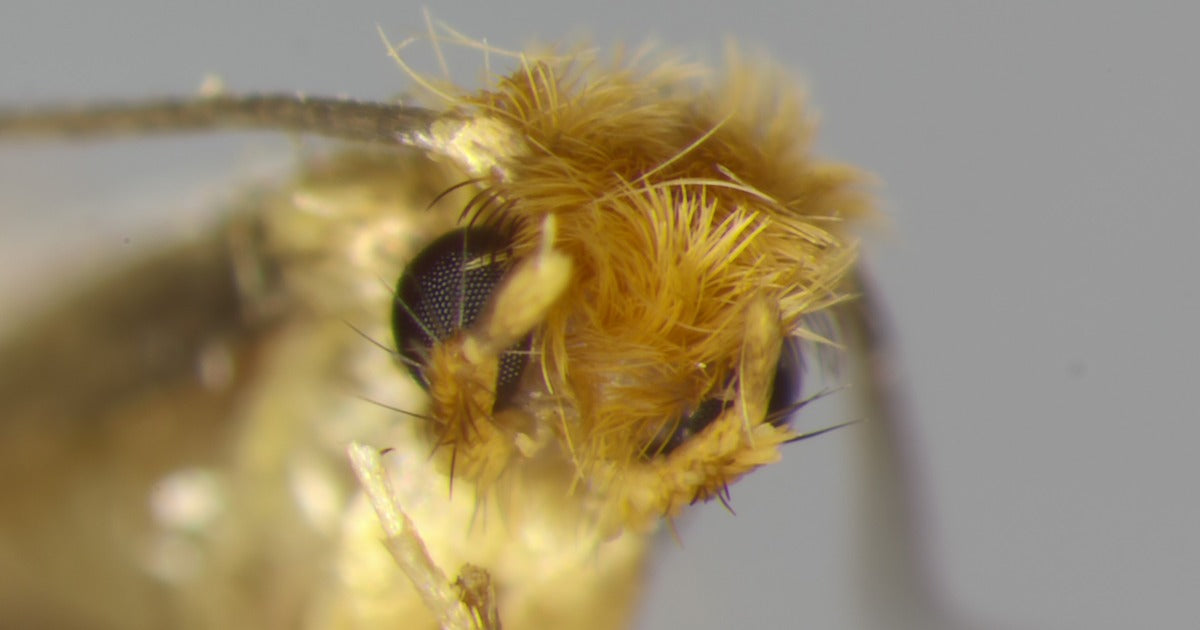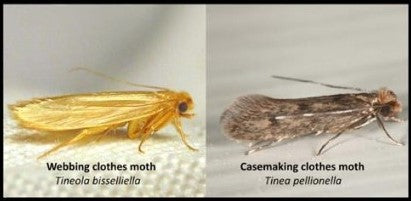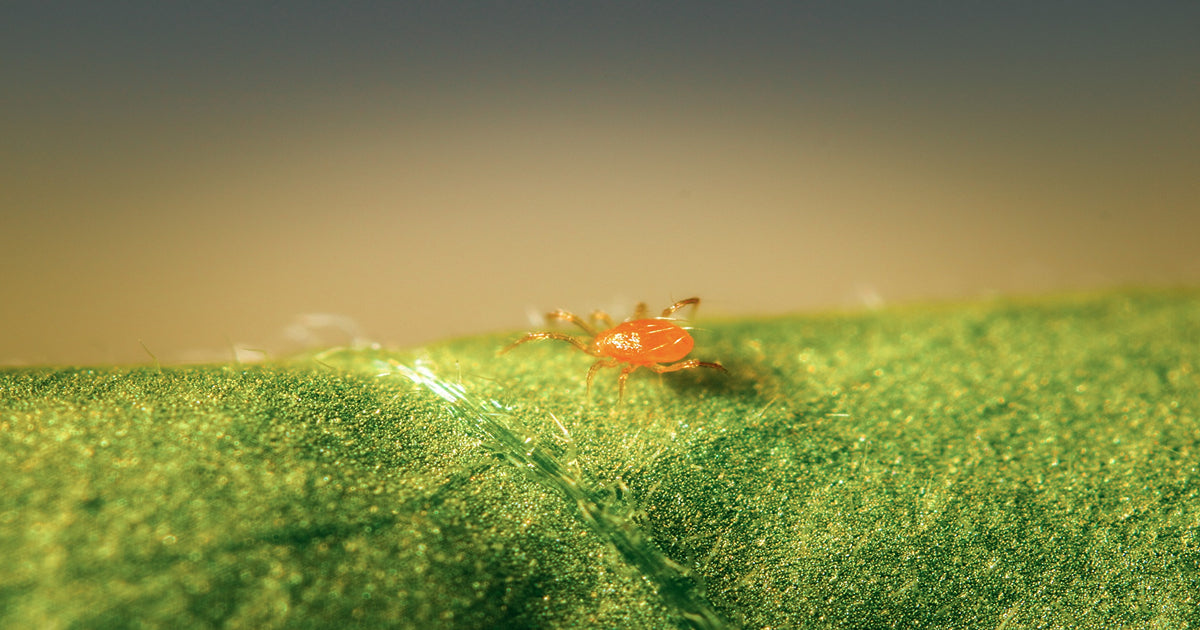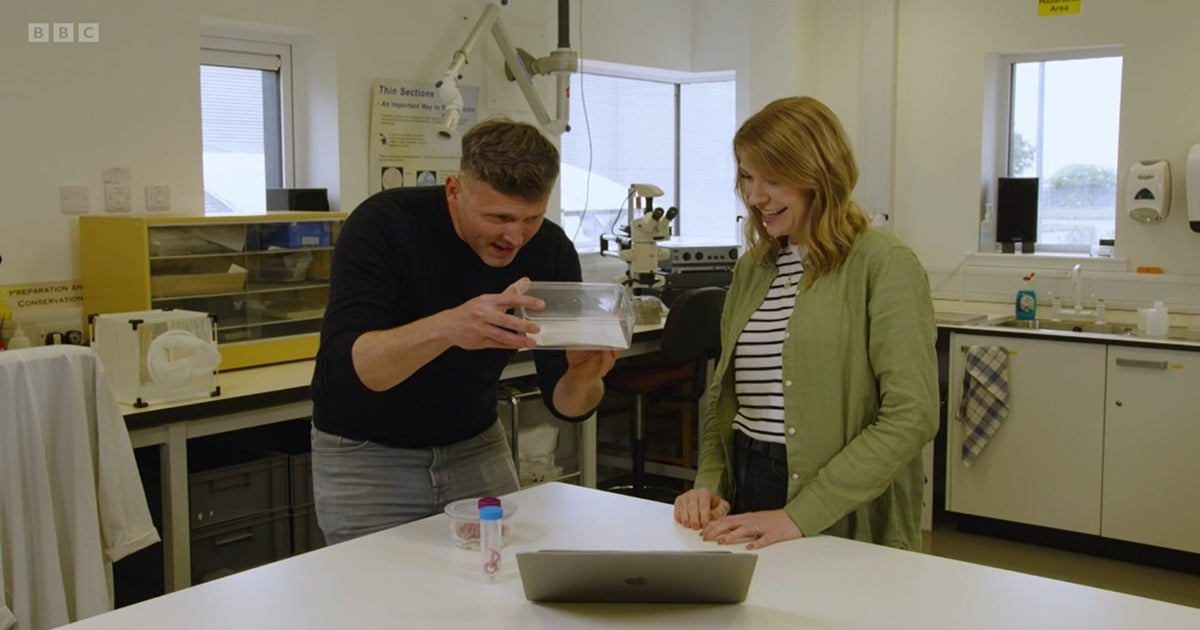
Clothes Moth Larvae Can Cause Extensive Damage To Knitwear, Carpets, Rugs & A Range Of Fabrics
Clothes Moths can be a common and consistent pest in homes. There are two main culprit species which cause similar damage. Most commonly identified is the Webbing Clothes Moth, Tineola bisselliella. The larvae of this species can be found feeding within a dense webbing. Another common Clothes Moth species is the Case-Making Clothes Moth, Tinea pellionella. The larvae of this species often create a small case for themselves out of clothing fibres.

The larvae of both these species of Clothes Moth will damage clothing fibres.
The larvae of Clothes Moth will feed on, and damage, many different types of garments, especially those of natural origin such as natural wool. Carpets can also be attacked, and warm, contained environments, such as wardrobes, cupboards and airing cupboards, provide an ideal environment for the larvae to develop. The larvae or caterpillars will make irregular holes in fabrics.

An example of typical Clothes Moth larvae damage to fabric.
Clothes Moths can be active all year round between temperatures of 10 and 33°C, with up to 4 life cycles per year. Although the adult moths may only survive up to a month, the larvae survive and feed for 2-3 months at a time.
Use Our Clothes Moth Traps & Trichogramma Parasitic Wasps To Fend Off Infestations
To identify if Clothes Moths are present before you sustain damage, we recommend placing a Clothes Moth Pheromone Trap near, or on, some clothing. This will lure and catch male Clothes Moths and provide you with an early warning of impending Clothes Moth activity.

Our Clothes Moth Traps lure & catch male Clothes Moths. This reduces mating, depleting moth numbers, and also provides you with an infestations indicator.
Clothes Moth Egg Killer Sachets
For a natural and biological control of Clothes Moths, introduce our Clothes Moth egg parasite: Trichogramma evanescens. These brilliant parasitic wasps will seek out Clothes Moth eggs, parasitising them and laying their own eggs inside, killing the unborn Clothes moth larvae. They are harmless to humans and animals and remain only for as long as there are Clothes Moth eggs present.
These tiny wasps are supplied inside a sachet which releases approximately 2000 wasps each week. Simply place the sachet within your wardrobes, cupboards, or drawers, or on top of clothing or infested carpets. Each sachet contains a readymade release hole so does not require opening.

Our Clothes Moth Egg Killer Sachets contain tiny parasitic wasps which parasitise and kill Clothes Moth eggs.
Select From Our Scheduled Programmes Of Clothes Moth Egg Killer Sachets For Best Results
The most effective way to utilise Clothes Moth Egg Killer Sachets is by opting for a scheduled programme of introductions. We have a wide range of programme options available to suit a variety of needs. The programmes are designed with the aim to fully break the Clothes Moth life cycles and range from introductions of 1 sachet per month for 2 months to 10 sachets per month for 12 months. Individual or single use instructions are also available if you'd like to see results for yourself before committing to a programme.

Opt for programme of Clothes Moth Egg Killer Sachet Introductions for best results.
Trichogramma wasps cannot be stored for more than a few days before use. When using multiple applications, opt for fresh deliveries rather than storing the sachets.
Comments (8 Responses)
Julie
Hi I have just taken delivery of the Trichogramma wasps and put the sachets out yesterday. Is it ok to vacuum or will I Hoover them up?
If I have to wait, how long until I can safely vacuum again?
Thanks Julie
Julian Ives
Hi Margaret, thanks for getting in touch.
I am sorry to hear of your Case Making Moth infestation and that the pheromone trap was ineffective thus far. I can confirm that the Trichogramma parasitic wasps contained within our Clothes Moth Egg Killer Sachets will indeed control the Case Making Moth as well as the Clothes Moth / Carpet Moth.
The wasps will parasitise the egg stage of the Case Making Moth if it locates the eggs at the right time of the Case Making Moth’s life cycle. Once the eggs are parasitised, the emerging Case Moth larvae will be killed and the egg used by the Trichogramma to reproduce in. More of these brilliant tiny wasps will then be released into the surrounding area to seek out further eggs to parasitise.
The Trichogramma will emerge from the sachets over a period of 2-4 weeks with nearly 2000 wasps emerging each week. Some patience may be required as the wasps can take 2-3 days to emerge, and emergence needs to overlap with proximity and availability of the egg stage of the pest moth’s life cycle.
Please let us know how you get on and I encourage you to persevere with this treatment as it has been highly effective for many of our customers and has fast become on our most popular product. Of course if you need any more assistance please don’t hesitate to get in touch again and we’ll be happy to advise,
Kind regards, Julian Ives [Director, Dragonfli]
Margaret Munro
I think I gave the case making moth. Smaller and darker than those in my previous house and none captured in the pheromone trap. I am on my second cycle of wasps preditors. Do they work for the case making moth or have I wasted my money?
Julian Ives
Hi Claire, thanks for getting in touch.
Yes we would still advise use of one sachet per closed space as the wasps will not be able to travel from room to room and you are giving yourself a much better chance of establishing control if each sachet is directly placed at the site of suspected infestations.
The sachets will release considerably more wasps than the old cards and will release wasps over a three week period to kill of the destructive Clothes Moth larvae.
Hope this helps but if you need any further advice please just let us know.
Kind regards, Julian Ives [Director, Dragonfli]





28 October, 2024
Julian Ives
Hi Julie,
Many thanks for getting in touch.
Once sachets are in situ, we would advise to avoid hoovering the area they have been applied in for 7-10 days. We understand that suspending hoovering for longer than this is unrealistic, so after such time has elapsed we suggest you try to hoover main thoroughfares only. Essentially it would be best to try to keep hoovering to a minimum for 3 weeks after application of the sachets to allow all of the tiny parasitic wasps to safely emerge to locate as many Clothes Moth eggs as possible.
I hope this helps but if you need any further assistance please don’t hesitate to ask and we’d be more than happy to help.
Kind regards, Julian Ives [Director, Dragonfli]